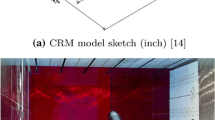Abstract
An implicit upwind-relaxation finite-difference algorithm solving the incompressible Navier-Stokes equations is employed to simulate low-speed, three-dimensional, laminar, leadingedge vortex flows over three round-edged low-aspect-ratio wings. The effects of grid density, angle of attack, Reynolds number, and wing planform on the flowfield structures and integral values are studied. Computed results are presented and compared with experimental data.
Similar content being viewed by others
References
Brennenstuhl, U. (1985). Private communication.
Brennenstuhl, U., and Hummel, D. (1982). Vortex formation over double-delta wing. Proceedings of 14th ICAS, Paper 82–6.6.3.
Chorin, A.J. (1967). A numerical method for solving incompressible viscous flow problems. J. Comput. Phys., 2, 12–26.
Harlow, F.H., and Welch, J.F. (1965). Numerical calculation of time-dependent viscous incompressible flow with free surface. Phys. Fluids, 8, 2182–2189.
Harten, A. (1983). High-resolution schemes for hyperbolic conservation laws. J. Comput. Phys., 49, 357–393.
Hartwich, P.-M., and Hsu, C.-H. (1988). High-resolution upwind schemes for the three-dimensional incompressible Navier-Stokes equations. AIAA J., 26, 1321–1328.
Hartwich, P.-M., Hsu, C.-H., and Liu, C.H. (1988). Vectorizable implicit algorithms for the flux-difference split, three-dimensional Navier-Stokes equations. J. Fluids Engrg., 110, 297–305.
Hsu, C.-H., Hartwich, P.-M., and Liu, C.H. (1988). Computation of vortical interaction for a sharp-edged double-delta wing. J. Aircraft, 25, 442–447.
Jaquet, B.M., and Brewer, J.D. (1949). Low-speed static-stability and rolling characteristics of low-aspect-ratio wings of triangular and modified triangular plan forms. NACA RM L8L29.
Kwak, D., Chang, J.C.L., Shanks, S.P., and Chakravarthy, S.R. (1986). A three-dimensional incompressible Navier-Stokes flow solver using primitive variables. AIAA J., 24, 390–396.
Luckring, J.M. (1979). Aerodynamics of strake-wing interactions. J. Aircraft, 16, 756–762.
Pan, D., and Chakravarthy, S. (1989). Unified formulation for incompressible flows. AIAA Paper 89-0122.
Rizzi, A., and Eriksson, L.-E. (1985). Computation of inviscid incompressible flow with rotation. J. Fluid Mech., 153, 275–312.
Roe, P.L. (1981). Approximate Riemann solvers, parameter vectors, and difference schemes. J. Comput. Phys., 43, 357–372.
Steger, J.L., and Kutler, P. (1977). Implicit finite-difference procedures for the computation of vortex wakes. AIAA J., 15, 581–590.
Thompson, D.H. (1985). A visualisation study of the vortex flow around double-delta wings. ARL-AERO-R-165, Melbourne.
Author information
Authors and Affiliations
Additional information
Communicated by M.Y. Hussaini
The work of the first author was supported by the NASA Langley Research Center under Contract NAS1-18585.
Rights and permissions
About this article
Cite this article
Hsu, CH., Liu, C.H. Simulation of leading-edge vortex flows. Theoret. Comput. Fluid Dynamics 1, 379–390 (1990). https://doi.org/10.1007/BF00271797
Issue Date:
DOI: https://doi.org/10.1007/BF00271797




